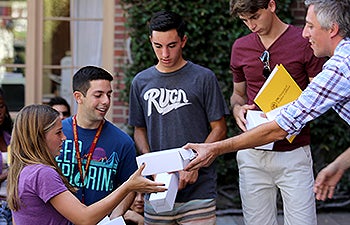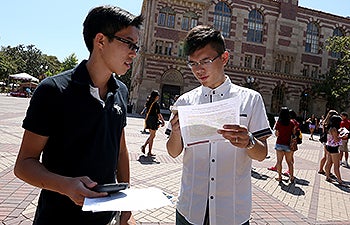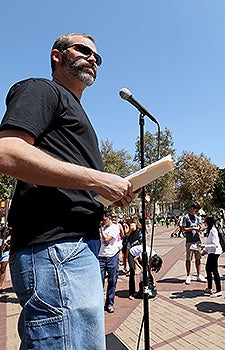GeoScavenge Challenge
Freshman Sidrah Khan, a biological sciences major from Scottsdale, Arizona, peered at her smartphone. She was using it to scan the matrix barcode affixed to the base of the statue of astronaut Neil Armstrong in Archimedes Plaza, located in the southwestern quadrant of the USC University Park campus.
Her teammates in this scavenger hunt, freshmen Jennifer Wang, also of biological sciences, from Porter Ranch, California; Molly Linder, a biomedical engineering major from Evanston, Illinois; and Tayanna Todd, a film and television production major from Monument, Colorado, crowded around her.
Khan read aloud the question that popped up on her screen.
“Neil Armstrong gave the Commencement Speech at USC in 2005. He asked students, ‘And what will the future bring?’ What was his answer? 1) ‘I do not know, but it will be exciting;’ 2) ‘An undefeated USC football season in 2014;’ or 3) ‘Hoverboards?’ ”
After conferring briefly, the freshmen picked the first option. Khan quickly submitted their answer on her smartphone. She and her teammates consulted the campus maps on their screens once more and set off toward Ronald Tutor Campus Center to search for the next clue.
Khan and her newfound friends were participating in the first-ever USC GeoScavenge, a Welcome Week event created by the Spatial Sciences Institute (SSI), housed in USC Dornsife.

Interdisciplinary GIS Library Fellow Andy Rutkowski presents gifts to participants. From left, Lindsay Sotnick, George Gatsios, Chistopher Bayrooty, Spencer Pearlman and Rutkowski.
During the activity, students used smartphones equipped with a matrix barcode — or QR — scanner app to navigate their way around campus as they searched for 23 clues located at different sites. Using the GeoScavenge Map (accessible on a smartphone via a QR scan) showing the clue locations, participants had one hour to visit as many clues as possible. At the site of each clue, students had to find the QR code, scan it and submit the correct answer to the related question that popped up on their smartphone.
Cognizant that the first week is always a challenging experience for incoming freshmen as they learn to orient themselves on the 229-acre University Park campus, SSI came to the rescue. By teaming up with the Office of Orientation, the institute was making that steep learning curve a little easier and a lot more enjoyable.
“The whole idea is to get a chance to explore campus while making new friends, discovering on-campus resources and learning about the history and culture of USC,” said Darren Ruddell, assistant professor of spatial sciences.
Wang participated for a chance to meet new people, get accustomed to campus and feel like a part of the Trojan Family.
“I’m going to feel much more confident about finding my way around now,” she said. Dormmates Wang, Kahn and Linder had joined up with Todd, whom they met at the event, to form a team. Although none were familiar with spatial science, all were curious to learn more.
“This event also serves to introduce students to some geospatial technologies,” Ruddell said. “We hope students will look at the map and think about routing — what would be the most efficient route to visit the sites of all 23 clues and get back to Tommy Trojan as quickly as possible.”

Two participants in the GeoScavenge event confer before setting off to try to find 23 clues hidden around campus.
SSI GeoDesign majors and spatial studies minor students were on hand to help incoming freshmen become familiar with the landmarks, layout, history and resources of the University Park campus.
“This is a way for interested students to talk with current students about the courses we offer and with faculty about what it’s like to think about the campus spatially,” said Susan Kamei, associate director of the SSI.
Melissa Turk, associate director of Orientation Programs, said she was delighted SSI had joined her office in offering the event to incoming students.
“The GeoScavenge is a perfect fit for us,” she said. “It’s a great program because students get the opportunity to learn the campus on their own. We know from experience that after taking a guided tour, students often say ‘I don’t really remember,’ but when they actively try to find places on their own, they have a better reference of where things are on campus. Plus, all these places are now tagged in their phone, so if they get stuck, they have all that information at their fingertips.”
At 2 p.m. on August 22, participants met at the Tommy Trojan statue, where Ruddell explained the rules and promised prizes to participants.
“We tried to mix fun USC trivia with a bit of USC history, while also providing information about academic programs and useful campus resources, like where to go to get a flu shot, learn about transportation or find a reasonably priced meal and issues such as sustainability,” said Interdisciplinary GIS Library Fellow Andy Rutkowski, who helped design the GeoScavenge challenge with Ruddell.

Darren Ruddell, assistant professor of spatial sciences, explains the rules of the GeoScavenge event during Welcome Week.
Among the questions the freshmen were asked to answer were:
Who first observed that USC athletes ‘fought like Trojans?’ How much does the globe on top of the Victor Kleinsmid Center weigh? Who is the official USC mascot? What decade was the globe in Leavey Library built? What is your favorite film featuring Doheny Library? Who is the unofficial USC mascot? Where can I eat as much sustainable, locally grown food as I want for just $10?
Once the hour was up, the participants reconvened at Tommy Trojan where Ruddell presented prizes — Universal Serial Bus (USB) drives and water bottles — to the 10 teams.
“The event offered freshmen a really fun way to explore campus while helping to promote spatial literacy,” Ruddell said. “Plus, it was good exercise and a great way to build friendships across disciplines by working collaboratively.”
As for Khan’s team, they were happy to each receive a USB drive for their completion of the GeoScavenge. Standing at the threshold of their academic careers at USC, the freshmen’s choice of answer to the Armstrong Commencement Speech question “And what will the future bring?” proved to be not only correct, but also an apt reflection at this time in their own lives:
“I do not know, but it will be exciting.”